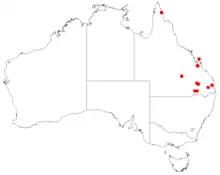| Leucopogon imbricatus | |
|---|---|
| Scientific classification | |
| Kingdom: | Plantae |
| Clade: | Tracheophytes |
| Clade: | Angiosperms |
| Clade: | Eudicots |
| Clade: | Asterids |
| Order: | Ericales |
| Family: | Ericaceae |
| Genus: | Leucopogon |
| Species: | L. imbricatus |
| Binomial name | |
| Leucopogon imbricatus | |
 | |
| Occurrence data from AVH | |
| Synonyms[1] | |
|
Styphelia imbricata (R.Br.) Spreng. | |
Leucopogon imbricatus is a species of flowering plant in the family Ericaceae and is endemic to south-east Queensland. It is an erect shrub with glabrous branches, crowded, often overlapping, egg-shaped leaves, and white, bell-shaped flowers that are bearded inside.
Description
Leucopogon imbricatus is an erect shrub that typically grows to a height of about 45 cm (18 in) and has widely-spreading, glabrous branches. Its leaves are sessile, egg-shaped with the narrower end towards the base and less than 13 mm (0.51 in) long. The leaves are crowded, often overlapping, and have a fine sharp point on the rounded tip. The flowers are arranged in leaf axils on a short peduncle with small bracts and broad bracteoles less than half as long as the sepals. The sepals are about 3 mm (0.12 in) long and the petals white, forming a bell-shaped tube about as long as the sepals, with lobes about as long as the petal tube.[2]
Taxonomy
Leucopogon imbricatus was first formally described in 1810 by Robert Brown in his Prodromus Florae Novae Hollandiae et Insulae Van Diemen.[3][4] The specific epithet (imbricatus) means "imbricate".[5]
Distribution
This leucopogon grows in south-east Queensland.[6]
References
- 1 2 "Leucopogon imbricatus". Australian Plant Census. Retrieved 28 December 2022.
- ↑ Bentham, George (1868). Flora Australiensis. Vol. 4. London: Lovell Reeve & Co. p. 215. Retrieved 28 December 2022.
- ↑ "Leucopogon imbricatus". APNI. Retrieved 28 December 2022.
- ↑ Brown, Robert (1810). Prodromus Florae Novae Hollandiae et Insulae Van Diemen. London. p. 545. Retrieved 28 December 2022.
- ↑ Sharr, Francis Aubi; George, Alex (2019). Western Australian Plant Names and Their Meanings (3rd ed.). Kardinya, WA: Four Gables Press. p. 222. ISBN 9780958034180.
- ↑ "Leucopogon imbricatus". Atlas of Living Australia. Retrieved 28 December 2022.